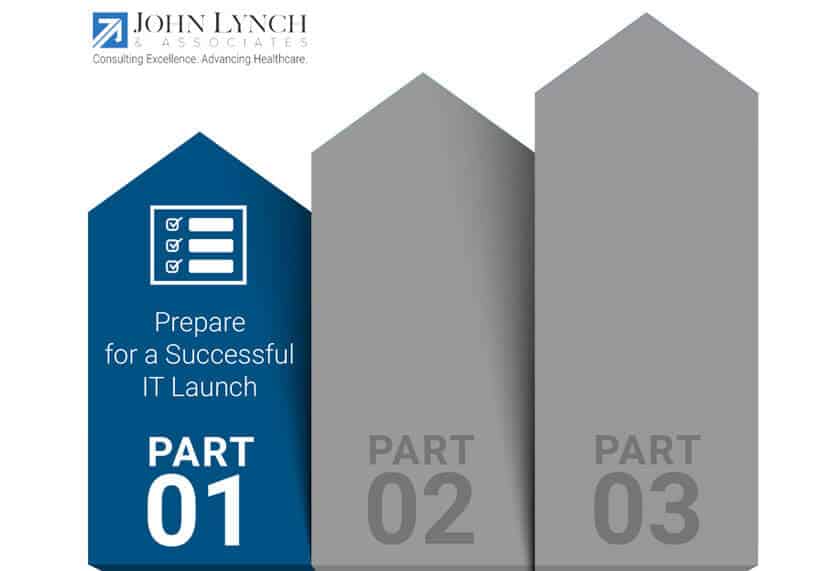In the healthcare industry, failure is not an option. In the best of circumstances, medical professionals as well as administrators give their all every day to help members of their communities live healthy, fulfilling lives. In the worst of circumstances, these same community heroes strive to mitigate risk, save lives, and improve quality of life in challenging times.
Those same principles of beneficence, non-maleficence, compassion, and duty expand to healthcare IT projects that build the infrastructure on which an entire healthcare organization is able to provide life-saving care.
The failure rate of healthcare IT projects is staggeringly high. In fact, a 2011 study found that healthcare information technology projects “fail at a rate up to 70% of the time when failure is defined as: ‘an HIT project in which an unintended negative consequence occurred, such as a project delay, a substantial cost overrun, a failure to meet an intended goal, or complete abandonment of the project.’”
When one system or fraction of the implementation goes wrong, it spreads like wildfire causing chaos and mismanagement to permeate even the most well-intended teams.
At John Lynch & Associates, our clients are confident that when our project management team steps in, the fires are put out before they ever draw a spark. In fact, the proven methodologies behind our successful healthcare IT projects are the topic of some of the most frequent questions we receive.
Today and over the next few weeks, we will be discussing the critical minutia of a successful healthcare IT project and how you can implement these tactics in your healthcare organization.
Article Highlights
- Rushed IT implementations often fail when organizations skip the foundational steps of strategic planning and alignment.
- Successful healthcare IT projects begin with clearly defined goals, scope, and stakeholder roles, not just urgency.
- Engaging operational, clinical, and IT teams early helps prevent confusion, rework, and resistance.
- A well-prepared organization sets realistic timelines and expectations, building trust across departments.
- Proactive planning reduces risk and ensures that technology investments lead to measurable improvement, not chaos.
The Source of the Blaze
The 10,000-Foot View
Oftentimes, IT project leaders are deeply personally invested in the success, failure, and perceived stability of a healthcare IT project – so much so that they are afraid to take a step back and examine the situation from a 10,000-foot view.
However, if we fail to approach a healthcare IT project from an objective vantage point, we also fail to take into consideration the biggest threats to the success of the endeavor.
If you need to bring in a third-party consultant to help you with this phase of the project, that is perfectly acceptable (and wise!). The critical point is that the objectivity must come from the first day a healthcare IT project is conceptualized or, unfortunately, the project will likely be ripe with fires to put out along the way.
What Does it Cost to Fail?
To answer this, we must acknowledge the need for an earned value analysis. According to the Project Management Institute,"Earned Value Analysis (EVA) is a method that allows the project manager to measure the amount of work actually performed on a project beyond the basic review of cost and schedule reports”.
If that value turns out to be negative, which it so often does with failed healthcare IT projects, the fallout can be catastrophic.
Healthcare IT projects such as EHR implementations almost always cost more than predicted and take longer than expected. However, those that take care to execute their project implementation with careful consideration of all of the most critical factors, will experience a successful project completion with final budget and timeline costs as close to predicted as possible.
Failure to do so comes at great cost, including:
- Missed incentive opportunities
- Staff attrition
- Patient dissatisfaction
- Physician frustration
- Legal ramifications
- A stained reputation within the healthcare industry

The No-Fire Healthcare IT Project Strategy
Over the next few weeks, I will reveal the most important strategies and processes to a successful healthcare IT project. Yes, what I propose is a great deal of work up front. The process is extremely methodical, strategic, and thoughtful; however, it will save you frustration, time, and money.
More importantly, using the John Lynch & Associates method will allow you to maintain and even strengthen the good rapport you have worked so hard to develop with your patients, the public, and future physicians – which, as we all know, is of increasing importance as the annual number of med school enrollments is dwindling.
The cost of doing it right the first time is far less than what it would cost to have a failed project. Make no mistake, a half-baked project is the same as a failed project. If it is not done right, then it is wrong.
I invite you to join me in a commitment to excellence – excellent planning, excellent communication, and excellent integrity. In doing so, not only will you set a powerful example for your healthcare organization as a whole, but also your diligent and thoughtful work will benefit countless patients for years to come.
Stay tuned for part 2 of my series: When Everything Is on Fire: The 3 Critical Strategies to a Successful Healthcare IT Project.
In the meantime, follow us on Facebook and LinkedIn to receive the latest updates or reach out to us with any questions about your next healthcare IT project.
Ready to Talk?
Related Articles

What Does a Healthcare Project Manager Do?

How a Healthcare IT Consultant Adds Value to Your Organization


